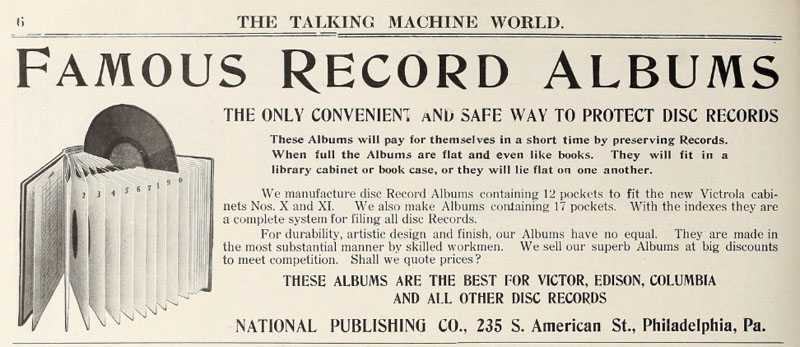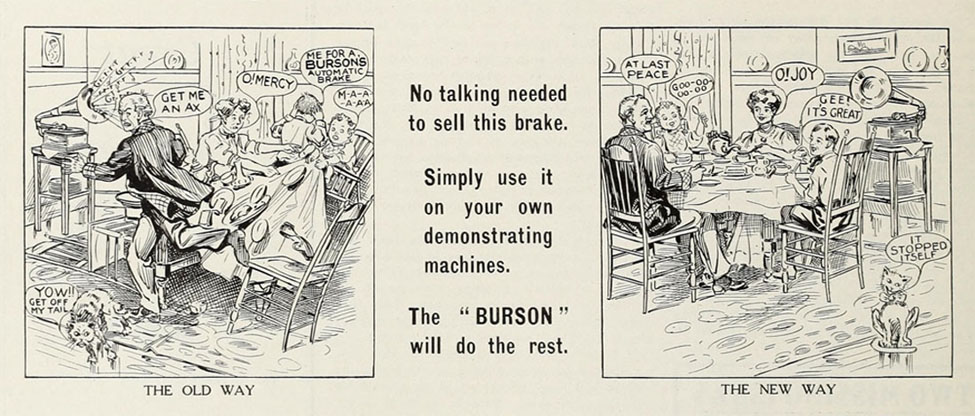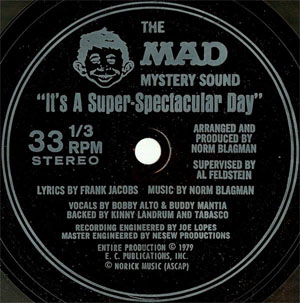Dictionary
of Phonographia

A whimsical dictionary of words and phrases connected
with the phonograph.(1)
"A phonograph
record or set of records containing a collection of musical selections
or sounds usually stored in a book designed to hold records or in
its own packaging for a single record."
Early disc records only had one
song per record, however, the discs could be stored in "albums"
that had multiple pages (record sleeves). These early record albums
resembled photograph albums which is appropriate since phonograph
records capture sound just as photographs capture pictures.
78 rpm album May 15,
1915, The Talking Machine World
Later record albums had multiple
songs on one long-playing (LP) record but these LPs continued
to be called albums since it was still a collection of music.
These early album "books" were usually undecorated and
sometimes were stamped on the spine with a letter of the alphabet
to help organize multiple albums in the record cabinet.
Record album art began in the 1940's
and often featured photographs and graphic art related to the
recording artist or illustrated a theme of the album.

45 rpm multiple record
tote ca. 1962
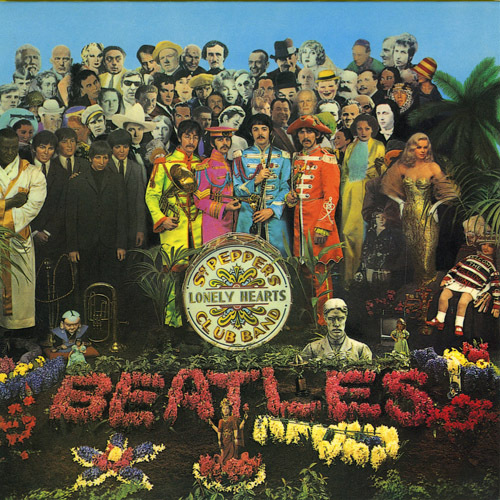
Beatles' LP Cover Art,
1967
Record album cover art changed significantly
in the late 1980's with the popularity of Compact Discs (CDs)
(although CDs had reduced sized "cover" graphics for
their jewel case packaging).
LP's and its cover art, however,
are survivors and the art on record albums will always give records
an identity and a place in recorded music history even when physical
albums do eventually disappear.
For more examples about the history
of albums and album covers see Record
Albums - A Brief History.
album cover (a.k.a. record album cover
art)
1) "An album cover is the front
of the packaging of a commercially released audio recording product,
or album... In 1938, Columbia Records hired Alex Steinweiss as
its first art director. He is credited with inventing the concept
of album covers and cover art, replacing the plain covers used
before. After his initial efforts at Columbia, other record companies
followed his lead. By the late 1940s, record albums for all the
major companies featured their own colorful paper covers in both
10- and 12-inch sizes. Some featured reproductions of classic
art while others utilized original designs. " Wikipedia.
2) "As a metaphor, the term album
cover can be used to describe a portrait of a group even if
they aren't a musical group/band. This 'album look' represents
a group in a way that the viewer feels that they are an authentic
group bound together even if they don't play instruments (like
the movie a Band
of Brothers is not about a musical band. See the photo
of the Blue Dogs released announcing its new leadership
— "Golden in a plaid short-sleeve shirt revealing his tattoos,
Gluesenkamp Perez sporting bangs, jeans and a denim shirt and
Peltola wearing a riotous floral blouse — was jokingly referred
to by some of their staff members as “the album cover.” The
Blue-Collar Democrat Who Wants to Fix the Party’s Other Big Problem,
The New York
Times Magazine, Jason Zengerle, July 1, 2024).
anniversary of your birth (a.k.a.
birthday anniversary, birthday) - see "birthday anniversary"
arum phonographicum
Sensitive and intelligent plant,
a.k.a. "Singing Lily," from Salesman's Seed Catalog,
Punch magazine 1911 (4)
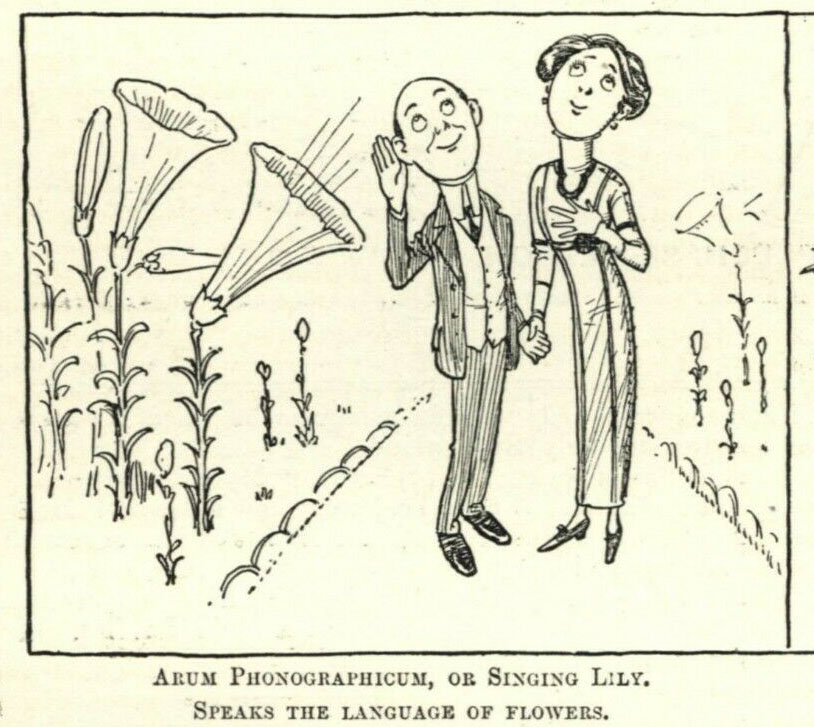

1907 Postcard
"as a matter of record"
a.k.a. "just for the record," "for the record."
This phrase is a double entendre
using "Record" as a noun meaning "an account in writing or the
like preserving the memory or knowledge of facts or events" and
as a physical phonograph record. With the invention of the phonograph,
the preservation of facts and aural events could be made using
records.

"As a matter of
"Record" Valentine's Day card, circa 1925 (PM-1081)

"For the Record..."
Hunter's Whiskey "Masterpiece," phonograph record, 1947
magazine ad (PM-0859)
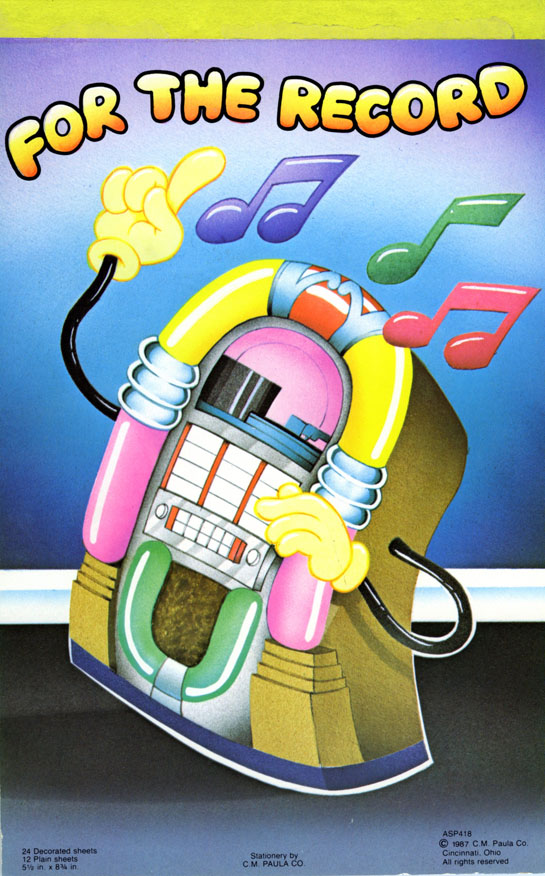
"For the Record,"
Stationery tablet cover, 1987 (PM-1483)
automatic stop
Bringing a turntable to a stop at
the end of a disc without human intervention. If the record is
not stopped the needle will continue into the non-recorded part
of the groove resulting in a distinct continous noise (or as the
Burson illustration depicts the annoying sound Gr-r-r-r Gr-r-r-r
Gr-r-r-r, etc.).
The Burson automatic brake advertised
in the Talking Machine World in 1908 humorously displayed
that without a mechanism to stop the record when it was done there
is chaos in the home. Avoid the "annoyance of jumping up
and rushing to stop the machine at the end of the record"
and let the family enjoy undistracted pleasure of a talking machine
with a Burson's brake. For "convenience," other
companies would also include this feature, e.g., Sonora 1910.
The Talking Machine World,
May 15, 1910 - Burson Automatic Stop cartoon - See
full Burson add plus additional Autostops
"beats all records"
(contraction of "beats all of the records")
As a "phrase" it is the
winner of the competition in whatever, surpassing any performance
of like kind as authoritatively recorded; the noun can be the
documented "accomplishment" which establishes the highest
result which can then be compared with previous and future results.
The noun can also be the physical medium used by phonographs to
play back whatever has been 'recorded" onto that medium.
In several early 20th century postcards
"beats all records" was used to note the superiority
of a phonograph related product or to humourously play with the
double meaning of the noun "record." See Merriam-Webster
definitions
of Record (noun) including its #4) something on which sound
or visual images have been recorded specifically : a disc with
a spiral groove carrying recorded sound for phonograph reproduction
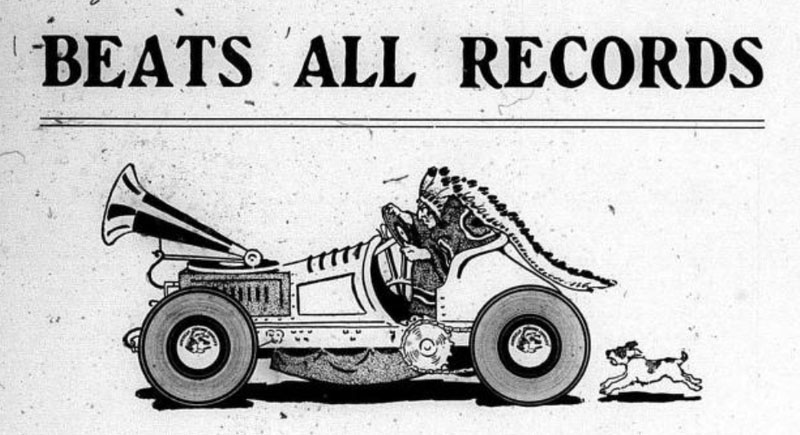
Portion of ad promoting the superiority
of Indian Records made by American Record Company,
The
Talking Machine World,
March 15, 1905, p. 2. Note the auto has "records"
for its tires.
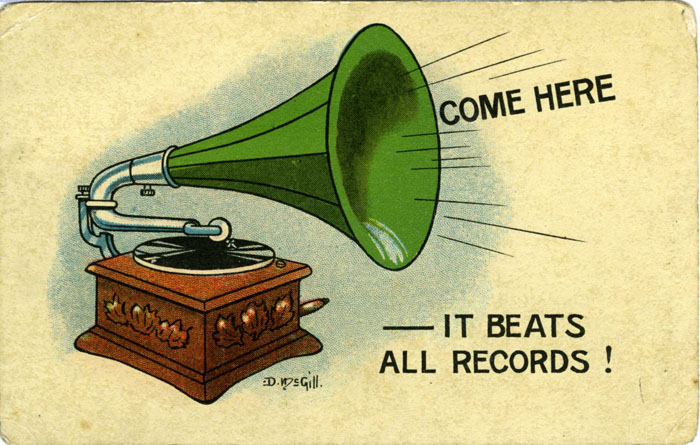
Postcard c. 1907
(PM-0273)
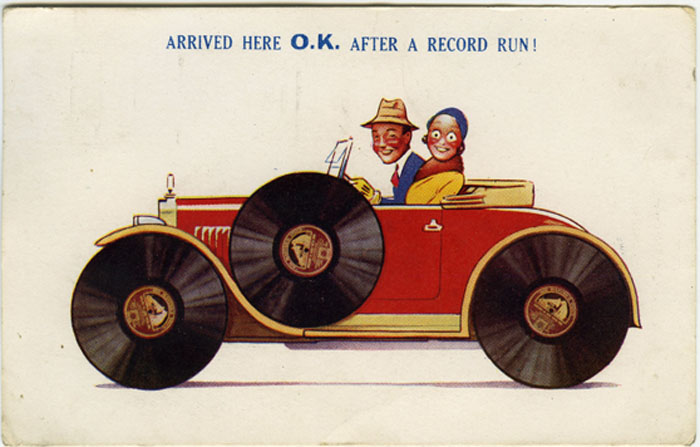
Postcard 1932 England
(PM-0471)
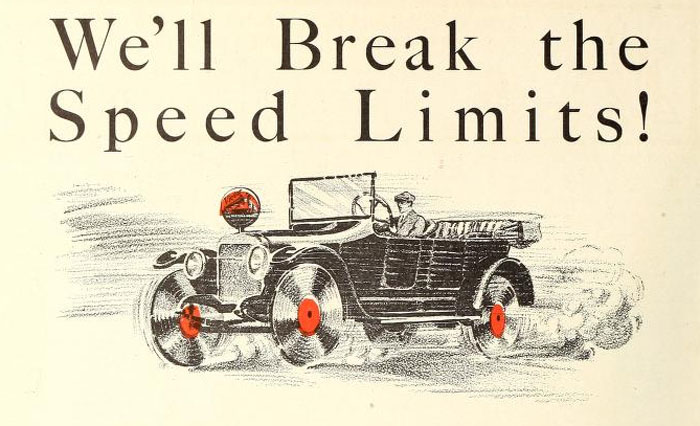
Victor Records Distributor's
ad, The Talking Machine World, January, 1916 (See
full ad)
birthday
anniversary (a.k.a. anniversary of your birth; birthday)
Official phrase used by Friends
of the Phonograph to mark the occasion of annually celebrating
a Friend of the Phonograph's date of birth. To send a birthday
message or birthday wish the recommended FOTP phrase
is "Happy Birthday Anniversary" or "Happy Anniversary
of Your Birth!" Although some dictionaries note that the
term "birthday anniversary" is not common, Friends
of the Phonograph point to its etymology, history of use and
connection with the phonograph, in particular the "turning"
which has a connection with the rotation of a cylinder or disc
when playing a record.
Middle English: from Latin anniversarius
‘returning yearly’, from annus ‘year’ + versus ‘turning’.
Example: "Mr. and Mrs Chris
Boilesen entertained the following, Sunday, in honor of their
daughter, Fern's birthday anniversary..." The
Phonograph (newspaper), St. Paul, NE, February 15, 1939
"canned music"
Phrase of derision often associated
with John Philip Sousa's article in Appleton's Magazine
in April 1906 where Sousa made his case against mechanical music
which he feared was becoming a “substitute for human skill, intelligence
and soul.”
Canned music
is "going to ruin the artistic development of music in this
country. When I was a boy...in front of every house in the summer
evenings, you would find young people together singing the songs
of the day or old songs. Today you hear these infernal machines
going night and day. We will not have a vocal cord left. The vocal
cord will be eliminated by a process of evolution, as was the
tail of man when he came from the ape."
 
Circa 1904 Edison cylinder
record stored in cylinder box, similiar to an early 1900 can of
baking powder.
An earlier use of "canned music",
however, appeared in O. Henry's McClure's magazine February
1903 story "The Phonograph
and the Graft." In addition to calling phonograph music
"canned" O. Henry also described the phonograph and
its records as "our galvanized prima donna and correct imitations
of Sousa's band excavating a march from a tin mine."
In the weekly column of The Lincoln
Evening News (Lincoln, Nebraska May 9, 1901), titled "Hot
Tamales" the author noted "About the worst use that
can be made of music is to grind it out of a phonograph."

Edison, dealer postcard
for advertising The New Edison, c. 1917
"can the picture"
An article in Photoplay Magazine,
describes how Mutual Film Company's music master Joseph O'Sullivan
works out his music cues without even looking at a piano. It is
as systematic as the compilation of a railroad time-table and
at least twice as accurate. The first step in this operation is
to "can the picture," this being shop talk for the operation of
dictating the plot and action of the picture, in the order of
its happening and at the rate of speed with which it happens,
to the wax record of a recording phonograph. "Shooting
the Music," Photoplay Magazine, March 1918.
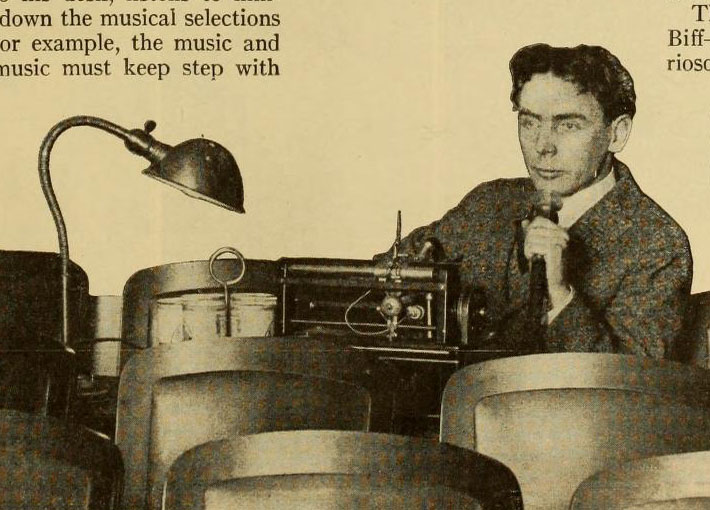
Joseph O'Sullivan, Mutual's music
master, paints tune poems to accompany the presentation of the
pictures in the theatres, the first step being to "can
the picture" into the wax record of his dictating phonograph.
"canned marriage proposal"
See "Cupid's
Story is Canned" for the newspaper story
about how one engagement announcement in Leominster, Massachusetts
in 1912 was performed using the phonograph.
"canned speech"
'Canned" originally referred
to putting something into a can or jar, e.g., canned peaches or
canned pumpkin. According to Merriam-Webster
Dictionary, 'canned' was first used in that sense in 1856.
With the introduction of recorded sound the "canning"
of music or words (particularly when used for political speeches)
was a term of derision. Canned speech became a generic
term for speech that was written beforehand that was delivered
unaltered.
In 1906 "canned speeches"
was a term said to be used by opponents of W.R. Hearst who was
running for governor and who made records for his campaign "to
be heard throughout the state" -- although not actually recorded
in his own voice as the article said "Mr. Hearst has a poor
voice — lacking the essential vibrant quality and depth — for
satisfactory sound reproduction." It was further noted that
"The Columbia Twentieth Century machine will be used. The
New York daily papers, in treating of this departure in campaign
methods, laud it highly, one of them saying: "It is not known
in whose fertile brain this scheme originated, but it looks very
much as if it would be a grand success, from a show stand- point
if from no other." See "Talker
Now Electioneering", The Talking Machine World,
October 15, 1906 for full article with its reference to these
"canned" speeches..."
Celebrity and political impersonation
speeches (e.g., McKinley original Speech is what Brainey is currently
recording) Judge, June 1897
Also see, human
phonograph record
connection
noun.
1. A state or fact of being connected
(bound, joined, brought together - from Online
Etymology Dictionary)
2. A relationship in which a person,
thing, or idea is linked or associated with something else. (from
Oxford Languages)
3. Connections for humans are "a
circular loop" and "an energy circle that goes back
and forth" See Yo-Yo
Ma and the Meaning of Life (6)
4. Connections for humans take place
within the "little circle" of man's experiences. See
My Antonia by Willa Cather (3)
5. Connections are part of "multiple
chronologies that are intertwined with each other" in "the
prismatic recollection of history." See Jenna
Wortham's How an Archive
of the Internet Could Change History (5)
6. Connections
can be based on degrees of separation but are not limited to the
definition of six
degrees separation of human relationships e.g., there can
be six degrees of separation in popular culture connections.
7. Connections with
the phonograph, i.e., Phonographia. (1)
cricket stridulation (e.g.,
how a cricket 'chirps' with the "file" on one wing
rubbed by the "scraper" on the other wing "like
the dragging of a phonograph needle across a vinyl record.")
The act of producing sound by
rubbing together certain body parts. This behavior is mostly
associated with insects, but other animals are known to do this
as well, such as a number of species of fish, snakes and spiders.
The mechanism is typically that of one structure with a well-defined
lip, ridge, or nodules (the "scraper" or plectrum) being moved
across a finely-ridged surface (the "file" or stridulitrum—sometimes
called the pars stridens) or vice versa, and vibrating as
it does so, like the dragging of a phonograph needle across
a vinyl record. - Wikipedia, extracted August 11,
2020
Note: Sounds
of crickets and frogs were included on the "Golden
Record" of Voyager 1 and Voyager 2.
See Phonograph
needle simile for definition and other examples, e.g., hearing
the sound of the 'pine siskin' bird.
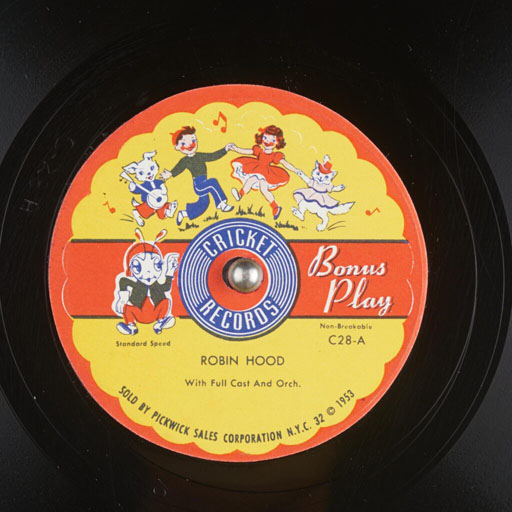
Cricket Records,
1953

10” 78 RPM / Mono
/ 1955
Culture
noun.
The way of life, especially the
general customs and beliefs, of a particular group of people at
a particular time. Cambridge Dictionary
"The way we express ourselves
and understand each other -- can bind us together as one world."
Yo-Yo
Ma
Disc Jockey a.k.a. DJ
A disc jockey, more commonly abbreviated
as DJ, is a person who plays recorded music for an audience. Wikipedia
discography
A list of sound recordings. These
recordings are not limited to recordings of phonograph records/discs
and can focus on cylinder recordings and other non-disc media
including phonautograms
created by Édouard-Léon Scott de Martinville.
earworm
An earworm, sometimes known as a
brainworm, sticky music, stuck song syndrome, or Involuntary Musical
Imagery (IMI), is a catchy piece of music that continually repeats
through a person's mind after it is no longer playing. Phrases
used to describe an earworm include "musical imagery repetition"
and "involuntary musical imagery". - Courtesy Wikipedia
(See WIkipedia for references and "In Popular Culture"
examples.

Courtesy Bizarro, Lincoln
Journal August 4, 2020
elevator music
Recorded music transmitted originally
by wires to commercial establishments like retail stores, restaurants
and even elevators to be played as background music. Muzak was
the tradename for a company that came to be dominant in this business
and ultimately Muzak became a generic term for background music.
Muzak or "elevator music" is another form of canned music
that Sousa probably would have railed against both for the quality
of selections but also for its pervasiveness (e.g, air pollution
in the aural sense).
ephemera
noun. "The minor transient
documents of everyday life" is a definition
formulated by the Ephemera Society's founder, Maurice Rickards.
The word ephemera is taken from the Greek: epi (on, about) and
hemera (day). Some libraries are now distinguishing ephemeral
printed matter from the more 'permanent' printed books and periodicals
with new codes and named collections e.g., Bodleian Library's
John Johnson Collection of Printed Ephemera. See The
Ephemera Society for additional information.
"The Ephemera Society is
a non-profit body devoted to the conversation, study and presentation
of printed and handwritten ephemera."
factola
noun. A
fact related to talking machines, phonographia and recorded sound
that is known through evidence and believed to be true.
A factola identifies
or highlights a popular culture connection with the phonograph
from various perspectives.
Etymology - Combination of 16th
century English definition of "fact" and suffix "-ola"
(which was used in naming over 180 talking machine brands in the
20th century, e.g., Victrola, Carola, Grafonola, etc.). The "-ola"
as a suffix associated with recorded music and talking machines
originates from the Aeolian Company's 1898 "pianola"
player piano named for the piano and the "viola" instrument.
The first known use of factola is from the 1982 draft of "Hats
Off to the Phonograph," by Doug Boilesen ©1982 and subsequently
used by Friends of the Phonograph and Phonographia.com.
1. A phonograph fact that is fundamental
to its legacy. Identifying a fact in this sense highlights
an established fact. For example, "The
Phonograph changed the human perception of ephemeral sound in
popular culture."
2. A phonograph fact based on its
position of being the first, or the most, or some other historical
distinction in the world of recorded sound. This type of fact
in popular culture is commonly identified as trivia.
3. A phonograph fact that is whimsical
or even obscure. These factolas could also be classified under
the trivia factola sense but usually require adding degrees
of separation to make the connection.
These factolas tend to bring a detail into the light (making
a connection that would otherwise remain unknown). For example,
there are multiple connections between the phonograph
and the sewing machine. One of the more obscure phonograph-sewing
machine connections is the factola that Mr. Charles Batchelor
(who would become Edison's chief assistant at Menlo Park, New
Jersey and who stands next to him in the April
1878 photograph taken at the Mathew Brady Studio of Edison
with his tin-foil phonograph) was a very skillful mechanic who
was sent "from England to superintend the setting up and
adjusting of the automatic thread machinery for the Clark Thread
Works." Interestingly, John Kruesi, who built the first phonograph
for Edison in 1877, went to work for the Singer Sewing Machine
Company at Elizabethport, New Jersey after he immigrated from
Switzerland in 1870.
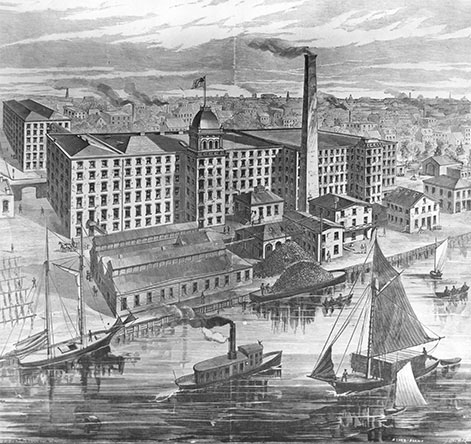
The Clark thread
mill on the banks of the Passaic River. The
Newark Public Library
fair fiction
1. A genre of historical fiction,
also known as "fairground fiction" where the story is
about, or set in, a world's fair.
2. A genre of "fair
fiction" where the story is about, or set in, a world's
fair and a connection with the phonograph is made in the story.
3. A genre of "fair fiction"
where the story is about, or set in, the 1893 World’s Columbian
Exposition. See the 1893
World's Fair website for this definition and cataloging for
their "Fairground Fiction" and Non-Fiction World’s Columbian
Exposition bookshelf.
field recording
Term used for an audio recording
produced outside a recording studio which applies to recordings
of both natural and human-produced sounds. - Wikipedia
Field recording can be traced back
to Édouard-Léon Scott de Martinville using his phonautograph –
the world’s first patented recording device - to capture 18 seconds
of the words“Au Clair de la Lune” on April 9th, 1860.
In 1889 an eight year old Ludwig
Karl Koch – the “Master of Nature’s Music,” as he would become
known – used his father’s wax cylinder recorder to capture the
first documented form of non-human sound: the song of a Common
Shama bird. In doing so Koch accidentally invented the notion
of preserving sound as a form of archaeology, creating an object
that could be stored for future generations". - Jack
Needham, Red Bull Music Academy Daily, March 24, 2017
(2)
"Field recordings" may also refer
to simple monaural or stereo recordings taken of musicians in
familiar and casual surroundings, such as the ethnomusicology
recordings pioneered by John Lomax, Nonesuch Records, and Vanguard
Records. Wikipedia
flipside
noun. The opposite side of something
is the flip side. In phonographia, this is often called the B-side
since the A-side of a 45 RPM was normally the hit recording and
the reason for purchasing the record.
Phonograph 33 1/3 and 78 RPM records
were also labeled Side A and Side B although like 45's they might
not say Side A but rather would have a number on the label followed
by the A or B, e.g., 83234A. For multi-record albums there could
also be Side C and Side D, etc.
"for the record"
- see as
a matter of record, "just for the record."
flexi disc
noun. Flexi disc (also known as
a phonosheet, Sonosheet or Soundsheet, a trademark) is a phonograph
record made of a thin, flexible vinyl sheet with a molded-in spiral
stylus groove, and is designed to be playable on a normal phonograph
turntable (Wikipedia definition). Flexible records were inserted
into magazines (like the Mad
Magazine example below, given away as promotional
ads, included with toys and dolls,
given to employees
or the format for a host of other creative uses.
Examples are courtesy of Michael
Cumella, WFMU and the wonderful website: The Internet
Museum of Flexi/Cardboard/Oddity Records Records Records.
Go there and learn more about these playable records that
are a fun part of the phonograph's history.
Friends of the Phonograph
(FOTP)

FOTP is a society that remembers
the legacy and wonder of the phonograph and recorded sound. Friends
annually celebrate the birthday of Edison's Phonograph on December
6. Begun as a family event circa 1977 there was no official name
until two charter members of the Emeryville-Oakland-Berkeley phonograph
birthday party group created a wooden sign in 1988 featuring Nipper
and the painted words "Friends of Phonography".
In 1990 the name of the society
was revised to Friends of the Phonograph. Despite a
revision to the name the original sign is annually hung at Friends
of the Phonograph birthday parties. The name became one of
Phonographia's main scrapbook galleries in 2001 (i.e., friendsofthephonograph.org).

Debbie and "Joey"
holding original sign at the Phonograph's birthday party in 1988.
garbage dump
A location where "things
that were once needed, useful or meaningful are redefined
as no longer wanted and relocated (dumped) to an area designated
for receiving unwanted material. Collectors and artists can
interrupt that process but what goes into landfills
normally descends "into a material purgatory, where everything
is mixed back into a primeval mess." ("Reframing
Trash Into Art" by Vik
Muniz, The New York Times, December 6, 2023.)
Golden Record
In 1977, one-hundred years after
the invention of the Phonograph, Voyager 1 and Voyager 2 were
launched. On the outside of each spacecraft was attached a 12-inch
gold-plated copper disk containing sounds and images selected
to portray the diversity of life and culture on Earth - essentially
a "message in a bottle" and "Greetings from Earth".
Now travelling in interstellar space
these phonograph records remarkably could end up outliving humans
on Earth.
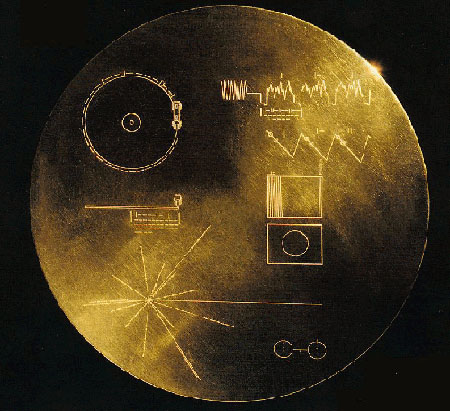
Voyager's Golden Record
cover
Grammy
noun. A Grammy Award, or Grammy,
is an award presented by The Recording Academy to recognize achievements
in the music industry. The trophy depicts a gilded gramophone.
The annual presentation ceremony features performances by prominent
artists, and the presentation of those awards that have a more
popular interest. -
Wikipedia
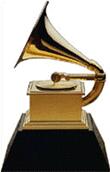
Gramophone
noun. Originally the name by which
Emile Berliner's disc talking machine was known, it became a generic
term to denote any disc playing talking machine, but fell out
of use in the United States - Glossary, Discovering Antique
Phonographs 1877-1929, Timothy C. Fabrizio and George F. Paul

Gramophone ad, McClure's
magazine, November 1896
gramopoem
noun. gramopoem
is a term coined in 1933 by John Murray Gibbon in "The
Magic of Melody" defining a poem created by "writing
love lyrics with machinery" and snatching lyrics "out
of a gramophone." Gibbon's process for creating a gramopoem
is as follows: "Take a gramophone and a record into a quiet
room and play it over and over; words in rhymed or unrhymed cadences
will come to you and the result will be poetry."
Etymology: "Gramo" from
Gramophone (grámma the
Ancient Greek meaning "letter" or "something written"
and used in branding Emile Berliner's 'talking machine,"
i.e, the Gramophone) and poem, the production of a poet
('something made' from Middle French poème, from Latin poema,
from Ancient Greek (poíema), from (poiéo, “I make”) - Wiktionary)
groove
noun. Long, narrow channel
or depression. In the context of a phonograph record it is the
track or channel of a phonograph record for the needle or stylus
to play the 'captured' sound waves that have been cut into the
record.
In describing when the spacecraft
Voyager I in the Fall of 1990 was getting close enough to Saturn
to see details that hadn't been seen by telescopes the 2017 critically
acclaimed documentary "The Farthest - Voyager in Space"
described Saturn's rings as looking "almost like the grooves
of a phonograph record."
See "in
the groove" for related usage
Hit Parade
A hit parade is a ranked list of
the most popular recordings at a given point in time, usually
determined by sales and/or airplay. The term originated in the
1930s; Billboard magazine published its first music hit
parade on January 4, 1936. It has also been used by broadcast
programs which featured hit tunes (sheet music and record) such
as Your Hit Parade which aired on radio and television
in the United States from 1935 through the 1950s. - Wikipedia
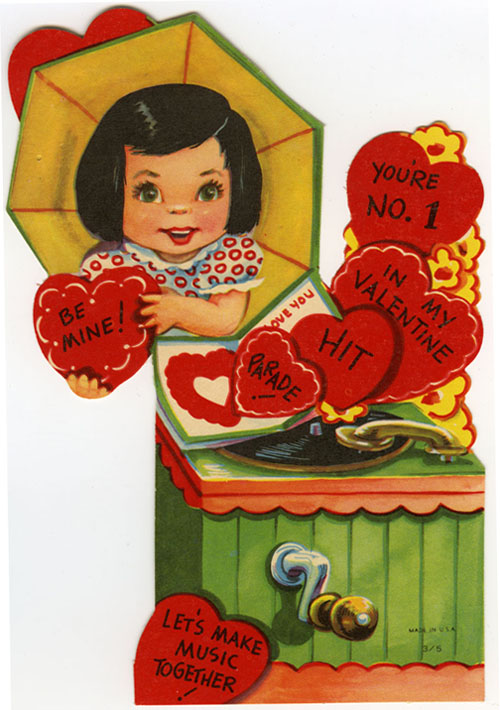
Valentine ca. 1940
"human phonograph record"
A metaphor used to compare a human
who repeats phrases or 'lines' like a phonograph record, usually
disparagingly.
Example - "You're a well-dressed
talker, a parrot full of commercial phrases, a human phonograph
record---and a phonograph record, if you play it all the time,
gets to be a nuisance."
"He
Produced the $100,000,000 Idea" by James Hay, Jr.,
The Popular Magazine, p. 124
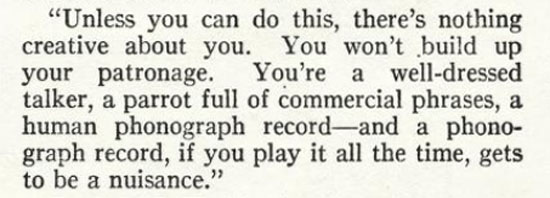
improve
verb - to make or become better
(definitions from Oxford Languages)
Origin - early 16th century (as
emprowe or improwe ): from Anglo-Norman French emprower (based
on Old French prou ‘profit’, ultimately from Latin prodest ‘is
of advantage’); -owe was changed to -ove under the influence of
prove. The original sense was ‘make a profit, increase the value
of’; subsequently ‘make greater in amount or degree’. (Oxford
Languages)
The phonograph industry has countless
examples of its technology and components being improved (or "perfected"
as Edison announced on June 16, 1888 his "PERFECTED PHONOGRAPH",
the same year he had months earlier announced his "Improved
Phonograph". To make the phonograph sound better, become
part of daily life and make a profit is the history of the phonograph
industry. Not a unique history in the consumer world. But certainly
lengthy and comprised by a variety of successes.
See ad for the 1897
Improved Berliner Gramophone.

Frank Leslie's Illustrated
Newspaper, March 1890
"in the groove"
noun. "Groove" is listed in dictionaries
as a long, narrow channel or depression. In the context of a phonograph
record it is the track or channel of a phonograph record for the
needle or stylus. The verb "groove" as slang continues to live
and is often associated with music, e.g., "to take great pleasure;
enjoy oneself: He was grooving on the music." The idiom slang
"in the groove" likewise can have some sexual connotations e.g.,Madonna's
song "In the Groove", but in general means to be "in the popular
fashion; up-to-date."
The link between "groove" and a
"phonograph groove" still exists, just like a musical "track"
is still the language used for selecting a song on an iPod (even
though there is literally no "track" or "groove" but rather only
the somewhat boring and mysterious computer file). Digital displays
on CD players and iPods could say "Groove 1" instead of "Track
1" when playing the first song of an album, but in this case "groove"
hasn't made the cut.
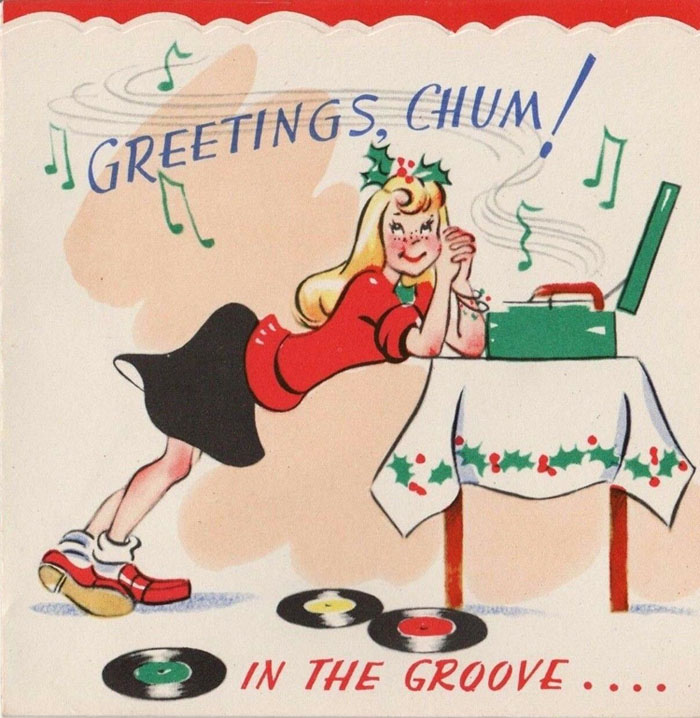
Christmas Greeting
Card ca. 1955
invention
noun. Something that has never been
made before, or the process of creating something that has never
been made before - Cambridge Dictionary
"An invention is an idea. It's
an idea that is useful. Somebody thinks of something and gives
us a new device, a new approach, a new technique." - Nathan
Myhrvold.
"In the late 19th century, Americans began thinking of their
country as a nation of inventors. Watch AMERICAN
EXPERIENCE "Invention in the Late 19th Century"
for a brief overview of a changing world as inventors and their
patents redefine the American identity."
"I Want to See a Phonograph
in Every American Home." Thomas A. Edison, 1907
Edison was explicit
that his Phonograph was the "perfect musical instrument"
and should be in every American home stating in a 1907 ad "I
want to see a Phonograph in Every American Home." And
there was no reason to wait. "On Free Trial. No Money
Down. No C.O.D."
looking "like the old RCA dog
looked at the phonograph"
Simile used to describe a quizzical
look with head cocked. In the 2004 U.S. Presidential Debate Number
3, October 13, 2004 commentator Paul Begala described the following:
Bush tried to make a joke about
media reports that have said Bush is misleading people...then
oddly stopped and chuckled to himself. All across America people
are looking at their TV's like the old RCA dog looked at the phonograph
-- head cocked, brow furrowed, with a quizzical look on their
face."
LP record (Long-Playing
Record)
"The LP (from "long playing"
or "long play") is an analog sound storage medium, a phonograph
record format characterized by a speed of 33 1/3 rpm, a 12- or
10-inch (30- or 25-cm) diameter, and use of the "microgroove"
groove specification. Introduced by Columbia in 1948, it was soon
adopted as a new standard by the entire record industry. Apart
from a few relatively minor refinements and the important later
addition of stereophonic sound, it remained the standard format
for record albums until its gradual replacement from the 1980s
to the early 21st century, first by compact discs and then by
streaming media." Wikipedia
Voyager 1 and Voyager 2 spacecraft
were launched in 1977 with each carrying a phonograph record that
is Earth's "message in the bottle" and "greetings from Earth."
This "Golden Record" is essentially an LP that plays
audio at 16 2/3, and as Carl Sagan noted, the record will only
be played "if there are advanced spacefaring civilizations in
interstellar space." So perhaps the "Golden Record" will never
be played. But there is still the mind-bending possibility that
the Voyager record will exist longer than humans on Earth and
that surely expands the definition of a "long-playing record."
Magic Lantern
The magic lantern, "also
known by its Latin name laterna magica, is an early type of image
projector that used pictures—paintings, prints, or photographs—on
transparent plates (usually made of glass), one or more lenses,
and a light source." Wikipedia
See David Robinson's
explanation of nomenclature problem in relation to "stereopticon."
NBC Chimes
Some sounds are iconic in popular
culture and the NBC chimes are one of those. In 1950 the NBC chimes
became the first "purely audio" service mark granted by the U.S.
Patent and Trademark Office. "The NBC chimes are a sequence
of three tones played on National Broadcasting Company (NBC) broadcasts."
See Wikipedia's NBC
Chimes for more details and to listen to NBC Chimes.
In 1932 Col. Richard Ranger, who
was involved in broadcasting and recording, developed the Rangertone
electronic chimes that replaced the manually-struck NBC chimes
on the network.

Richard Ranger "Rangertone"
tape recorder at the Pavek
Museum of Broadcasting

NBC Xylophone, c. 1930,
gift of NBC Radio Chicago, WMAQ - Museum of Science and Industry
(Chicago)
needle
noun. The point (usually steel)
of the SOUNDBOX which rides the grooves of the recording and transmits
vibrations to the DIAPHRAGM. (Definition from The Talking Machine
by Fabrizio and Paul) TMC2.
nostalgia
noun.
1) A sentimental longing or wistful
affection for the past, typically for a period or place with happy
personal associations. - Oxford
Languages Dictionary
2) Something done or presented in
order to evoke feelings of nostalgia. An evening of playing old
records. Listening to a phonograph record repeatedly for the memories
it contains. See Phonographia's The
Our Song Phenomenon.
-ola
suffix - "-ola"
was used in 1898 with the introduction of the pianola by the Aeolian
Company in New York. The pianola was a specific name for the player
piano manufuctured by the Aeolian Company but it would become
a generic term for all player pianos. Its name may have originally
been based on "piano" and "viola".
When
the Victor Talking Machine Company introduced their new cabinet
model Victor gramophone in August 1906 they named it the "Victor-Victrola".
There are over 100 phonograph or music playing machines that use
"-ola" as a suffix for their brand name.
"ok after a record run"
Phrase was used on a postcard mailed
in November 1932 where the postcard shows a roadster that has
Victrola records for tires. The phrase uses the double entendre
"Record" for the literal meaning of having records for wheels
and running on records, and for the meaning of "record" as the
highest or best rate, amount, etc., ever attained, esp. in sports
e.g., to hold the record for home runs.
"On
this day in the world of Phonographia"
This calendar on Phonographia.com
(a.k.a. "On This Day" PhonoCalendar) features days
from 1877 to the present with phonograph connections in popular
culture. It's typical of the "scrapbook" design of
Phonographia.com with its lists - in this case somewhat random
lists of phonograph connected days organized by months. Better
websites are certainly available for "On
this day" music and history events (sometimes called
'channels') but Phonographia's "On this Day" does
include items that are unlikely to be found on any other "On
this Day" calendar.
noun. Payola is a
secret or indirect payment (as to a disc jockey) for a commercial
favor (as for promoting a particular record), in the music industry
- Merriam-Webster
The term was coined
in 1938 when entertainment industry publication Variety
combined the words "pay" and "ola" as in "Victrola."
See the History Channel's This Day in History which calls
February 11, 1960 the day the "Payola scandal reaches a new
level of public prominence, when President Eisenhower called it
an issue of public morality ..."
phonautograph
noun. The phonautograph is the
earliest known device for recording sound. Previously, tracings
had been obtained of the sound-producing vibratory motions of
tuning forks and other objects by physical contact with them,
but not of actual sound waves as they propagated through air
or other media. Invented and patented by Édouard-Léon Scott
de Martinville on March 25, 1857. - Wikipedia
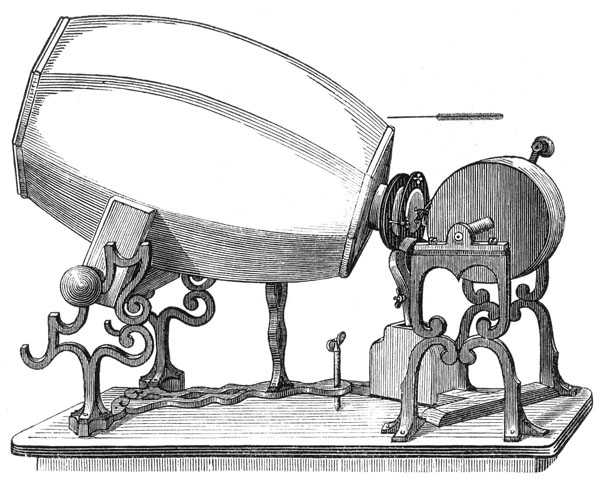
Phonautograph, 1859
PhonoAvenue
noun. A virtual street lined with
phonograph museums where Friends of the Phonograph can
visit. PhonoAvenue features
phonograph museums from around the world with examples from each
collection.
phonogram
noun. A Phonogram is a grapheme
(written character) which represents a phoneme (speech sound)
or combination of phonemes, such as the letters of the Latin alphabet
or the Japanese kana. For example, "igh" is an English-language
phonogram that represents the hard "I" sound in "high". Whereas
the word phonemes refers to the sounds, the word phonogram refers
to the letter(s) that represent that sound. - Wikipedia
Phonogram - The original name given
by Thomas Edison to his cylinder records, suggesting their intended
use for business purposes. Later, musical cylinders were called
"records." - The
Routledge Guide to Music Technology
The Phonogram - "The
Official Organ of the Phonograph Companies of the United States"
published monthly from January 1891 to April 1893. It was "a
magazine devoted to all interests connected with the recording
of sound, the reproduction and preservation of speech, the Telephone,
the Typewriter, and the progress of electricity."

phonogram craze
Enthusiasm for collecting and listening
to recorded sound (see phonogram)
for a specific reason which can have short-lived popularity.
One phase of the early phonogram craze
was noted in The New York Times, December 14, 1890, as the
collecting of the voices of actors and singers from the stage for
personal use in the home -- what the Times called "voice
photographs that make the drawing room a theatre." This "source
of entertainment has become exceedingly popular in New York. A photograph
of the human voice is much more valuable to the curious collector
than a picture of the face, even when accompanied by an autograph.
There is something peculiarly weird and attractive in the idea of
calling up at will some friend or famous character and listening
to an exact reproduction of his or her voice."
An example of this "craze"
is one gentleman of this city who "has secured cylinders representing
vocally nearly every artists of any note who has been seen here
for the last year."
phonograph
noun. Phonograph is what
Edison named his invention which was completed on December 6,
1877and was the first device to successfully record and reproduce
the human voice.
The term phonograph ("sound writer")
is derived from the Greek words meaning "sound" or "voice" (and
transliterated as phone-) and "writing" (transliterated as graphe-).
Similiar terms gramophone and graphophone have the same root meanings.
The coinage, particularly the use of the -graph root, may were
probably influenced by the then-existing words phonographic and
phonography, which referred to a system of phonetic shorthand;
in 1852 The New York Times carried an advertisement for
"Professor Webster's phonographic class," and in 1859 the New
York State Teachers' Association tabled a motion to "employ a
phonographic recorder" to record its meetings.
F. B. Fenby was the original author
of the word. An inventor in Worcester, Massachusetts, he was granted
a patent in 1863 for an unsuccessful device called the "Electro-Magnetic
Phonograph". His concept detailed a system that would record a
sequence of keyboard strokes onto paper tape. Although no model
or workable device was ever made, it is often seen as a link to
the concept of punched paper for player piano rolls (1880s), as
well as Herman Hollerith's punch card tabulator (used in the 1890
United States census), a distant precursor of the modern computer.
Arguably, any device used to record
sound or reproduce recorded sound could be called a type of "phonograph,"
but in common practice it has come to mean historic technologies
of sound recording. - Wikipedia
For a list of of talking machines
that used 'phon,' 'fone,' 'phone,' 'graph,' and 'graf' in their
company branding see Phonographia's Factola The 'Phon'
and 'Graph' Brands
For an excellent description of
how the 1876 telephone contributed to the invention of the Edison's
1877 phonograph, see The
American Experience video Edison: From the Telephone and
Telegraph Comes the Phonograph
phonograph
noun. An irritating toy that restores
life to dead noises. - Ambrose Bierce, The Devil's Dictionary,
1911

"Infernal talking
machine " postcard ca. 1908
phonograph
noun. Used as a metaphor to describe
a human talking repetitiously or constantly e.g., "The
family's phonograph" which plays the 'record' of a baby
crying over and over.
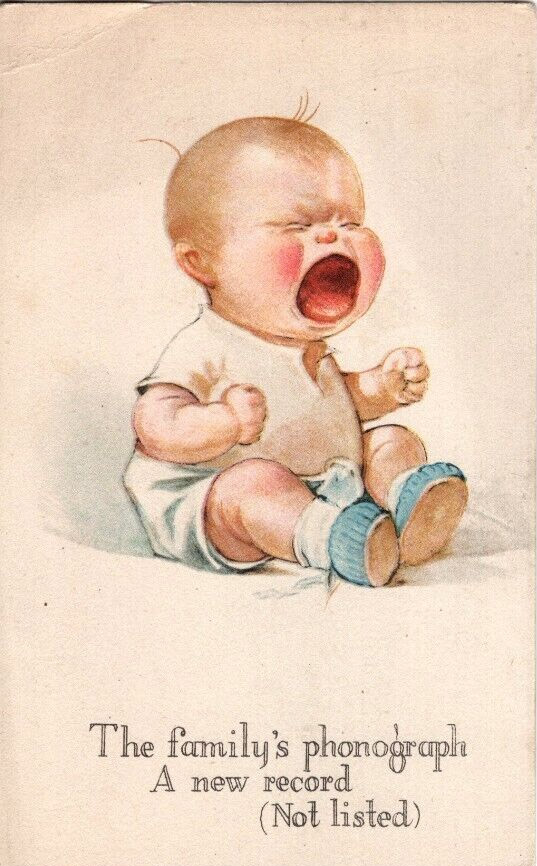
"The family's phonograph"
postcard ca. 1930 (PM-2097)
phonograph
noun. A "galvanized prima
donna" which can produce "correct imitations of
Sousa's band excavating a march from a tin mine." A
machine that can make "hamburger steak out of the hitherto
respected art of music." - O. Henry, "The Phonograph
and the Graft," McClure's Magazine, 1903.
phonograph game
1. A game that is dependent on a
phonograph record for outcome of the game, e.g., progress of the
game, instructions, steps.
2. A game that uses a phonograph
record to provide sound effects or 'atmosphere' for the game.
3. A toy or game constituting an
attachment for a flat disk phonograph and designed to convert
the phonograph into a toy or game of chance or into a combined
phonograph and game.
4. A speculation process which created
prices for stock quotations on the phonograph, playing them back
and then recording those quotes on the board. Developed by the
Public Stock Exchange which was incorporated in San Francisco
in December 1890 its by-laws stated that "stocks may be
bought and sold by oral expression or by the reannouncement of
orders on a phonograph in the exchange room. When a phonograph
is used to make the bids and offers it shall be done aloud so
that all may hear it and a record made at once of each offer to
buy and sell on a blackboard in the Exchange room. The phonograph
thus used is designated the "Main Phonograph." See
BOGUS STOCK GAMBLING."
Chief Crowley Says He Will Raid the Phonograph Game for
details about creating the prices for stock quotations on the
phonograph, playing them back and then recording those quotes
on the board. The Examiner, November 7, 1891.
See PhonoGames
for examples of the above.
phonographitis
noun. A new disease, not listed
in any known text book on medicine, invaded Pasadena in December
1906. "Symptoms of the disease have been manifested in the
past, but lately it has assumed a more virulent form and its victims
are numberless....There is an extraordinary demand for Edison
phonographs and it is difficult to fill all of the orders"
according to the Waterhouse Music Company and The Edison Phonograph
Monthly, December 1906.
Phonograph Needle Simile
A phrase or comparison that relies
on the reader or listener being familiar with the sound of a phonograph
needle scratching across a record.
"makes a sound resembling
a needle dragged across a phonograph record."
"When words fail, birders resort
to analogous sounds to describe vocalizations. The gang-gang cockatoo
and Montezuma oropendola sound like creaking hinges. The black-and-white
warbler sounds like a squeaky wheel, while the field spar- row
sounds like a ping-pong ball bouncing on a table. The pine siskin
makes a sound resembling a needle dragged across a phonograph
record, while the rufous whistler can sound like a stuck record"
- from VERBATIM VOL. XXVIII, NO . 1 - The Language Quarterly,
Winter 2003 (VERBATIM, a periodical devoted to "Translating
the Language of Birds")
Listen to needle scratching
a record HERE
"...squeaking like a phonograph
needle scratched across the grooves."
"At this point, instead
of turning back to find an alternate route, he began to move in
circles, squeaking like a phonograph needle scratched across the
grooves." Flowers for Algernon by Daniel Keyes, Mariner
Books, Houghton Mifflin Harcourt Publishing, New York ©1994
p. 239
phonographia
noun. Phonographia are all things
in popular culture that can be connected with the Phonograph.
These can be objects, recorded sounds, facts, stories, ephemera,
memorabilia, people, places, events, moments in time — whatever
is part of the popular culture memory of the Phonograph is Phonographia.
Phonograph connections, interconnections,
and multiple degrees of separation, each with its own string and
story, define phonographia.
The
'three Rs" of Phonographia, i.e, Relate, Reference and
Remind, have multiple sources for their connections: as art, advertisements,
personal stories, literature, photographs, newspapers, movies,
greeting cards, postcards, cartoons, sheet music, comics and anything
else in popular culture from which a 'connection' can be made
with the phonograph.
phonographian
noun. A Phonographian is Friend
of the Phonograph who enjoys all connections to the Phonograph.
Example: A Phonographian playing
Pinochle will always bid "33 1/3" instead of 33 when
given the opportunity.
Example: Important birthdays for
Phonographian's are 16 2/3, 33 1/3, 45, and 78.
Example: A "Phonograph Red-Letter
Day" and major holiday of the year is December 6, the anniversary
of the completion of Edison's Phonograph.
The Motto of Phonographians: "Save
Energy - Wind a Phonograph!"
The Mission Statement of Phonographians:
"Remember the Phonograph!"
The Mantra of Phonographians: "It's
a Revolution still turning!"
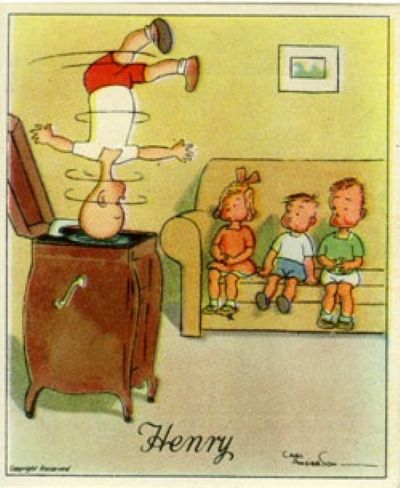
The Early Training of a Phonographian.
phonographic piano - The
Phonograph Set to Music
1878 invention capitalizing on Edison's
Phonograph
Courtesy NYPL - The
Miriam and Ira D. Wallach Division of Art, Prints and Photographs:
Picture Collection, The New York Public Library. "The phonograph
set to music." The New York Public Library Digital Collections.
1878-12-28. http://digitalcollections.nypl.org/items/510d47e3-1d77-a3d9-e040-e00a18064a99.
phonography
noun.
1. Pitman shorthand, a system of
shorthand stenography developed by Isaac Pitman (1837). Andrew
J. Graham, author and teacher of stenography, developed the Graham
shorthand system and was conductor of the Phonetic Academy, New
York (1860)
2. Field recording of natural sounds,
also called phonography (a term chosen to illustrate its similarities
to photography) - Wikipedia
3. Phonography (album), the 1976
debut album by R. Stevie Moore
4. Phonography
(song), from 2008 Circus album by Britney Spears

Andrew Graham’s stenography
(1860) for “Phonographic students”.
.

Phonography
(album), 1976 by R. Stevie Moore
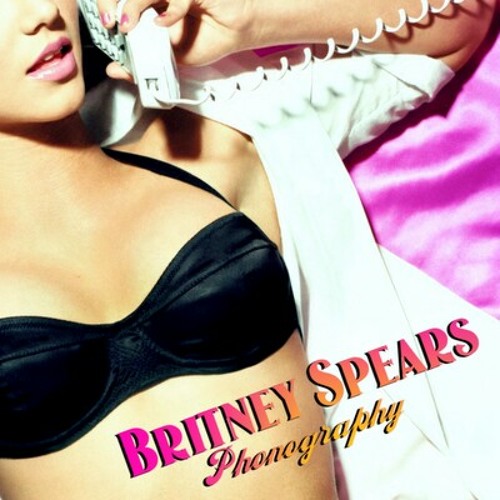
Phonography
(song), from 2008 Circus album by Britney Spears
Phonograph Industry - See "Connections
and the Phonograph
Industry"
Phono=Record Post=Cards,
1905
A novelty postcard designed to have
a thin transparent record over the picture on the postal card
which can still clearly be seen. Provides a multi-media experience
in receiving a postcard, i.e., music and the image on the postcard.

Phono=Record Post=Cards,
The Talking Machine World, March 15, 1905
Platters, The
A vocal quartet formed in 1953 that
would eventually be named The Platters. "The name
came from the metal disk, or “platters,” that rotate vinyl records
and facilitate the playing of recordings on the turntable of a
phonograph." The "original" quartet was formed
by "a recently discharged young Army veteran named Herb
Reed who recruited Cornell Gunther, Joe Jefferson, and Alex Hodge."
See
1953, The Platter's History.
When the radio started broadcasting
music from records its list of records that the station played
would become known as its "playlist." That list became
a problem in the music industry as it historically included records
selected by the illegal practice known as Payola which involved
payments being made to "commercial radio stations to play
a song without the station disclosing the payment. Under U.S.
law, a radio station must disclose songs they were paid to play
on the air as sponsored airtime." (Wikipedia, Payola).
The selection of recorded
music and Top100 lists would be dependent on radio stations for
decades until technology provided new options to create personal
music playlists. The introduction of cassette tapes, personal computers,
mini-discs, compact discs (CD-R), on-line file (music) sharing programs,
and streaming services allowed users to create their own playlists
on the new media. Devices to play that media included some very
popular portable devices such as Sony's Walkmans (cassette, CD,
and MZ1 minidisc, MP3 players), mobile phones and smartphones, and
Apple's iPod. Peer-to-peer file sharing software like Napster also
involved legality questions but ultimately the evolution of playlists
meant that personal choices of songs and the order those songs played
was within the control of its users.
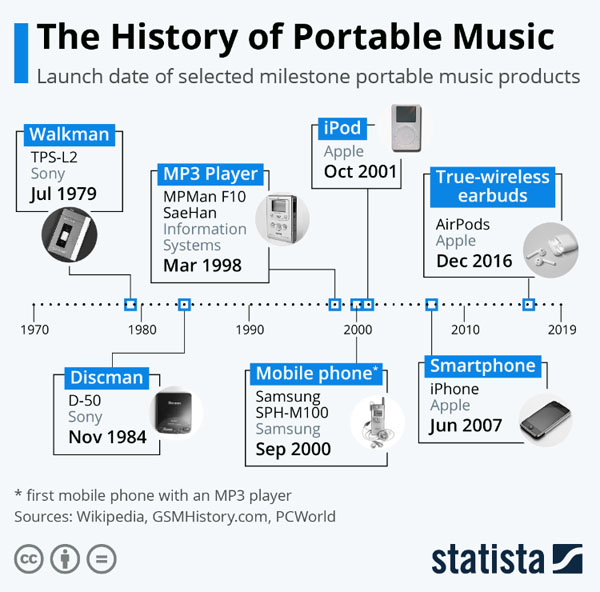
Portable Music Milestones
(Source: Statista
2023)
Besides organizing your own favorite
songs, personal playlists are a way to share those favorites with
others. Additionally, software on most computers has the "shuffle"
feature which randomizes at one time the order the songs will play
(i.e., shuffle playback prevents repeated tracks, as opposed to
random playback where the next track is chosen at random after each
track has played).
Playlists, whether personal, social
or generated by computer programs continue to promote 'records'
and recorded sound in popular culture.
popular culture
"Popular culture is generally
recognized by members of a society as a set of the practices,
beliefs, and objects that are dominant or prevalent in a society
at a given point in time. Popular culture also encompasses the
activities and feelings produced as a result of interaction with
these dominant objects. Heavily influenced in modern times by
mass media, this collection of ideas permeates the everyday lives
of people in a given society. Therefore, popular culture has a
way of influencing an individual's attitudes towards certain topics....Popular
culture is constantly evolving and occurs uniquely in place and
time." - Wikipedia
Popular culture examples in Phonographia
are mostly phonograph connections with visual
culture, popular music, advertising, paper media, and consumerism.
priceless
noun. "Explaining to your grandchildren
what a record is: Priceless" (Mastercard, 2004)
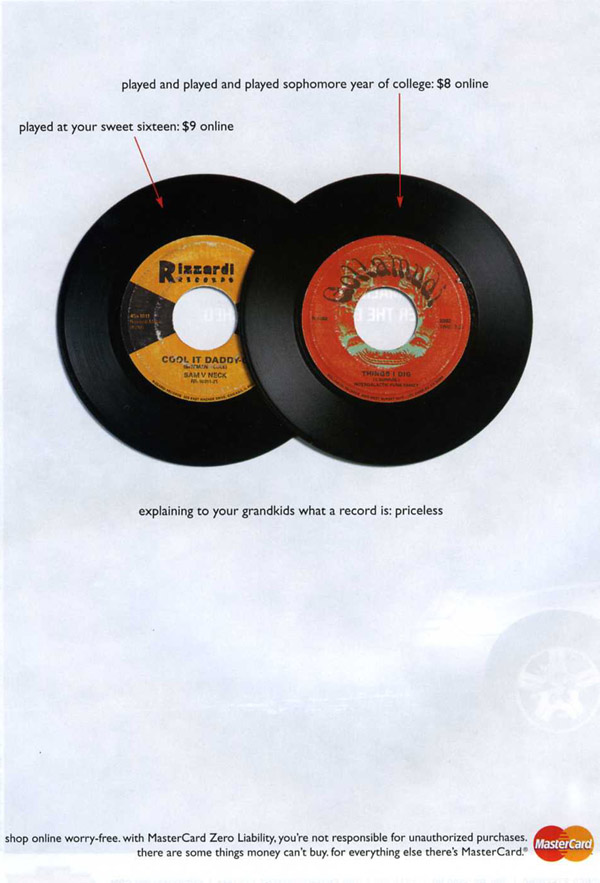
MasterCard, 2004
"put a sock in it"
This phrase is generally thought
of in the context of someone being noisy and these words being
the colorful request to quiet down. Interestingly, many believe
that this phrase actually originates with the phonograph being
noisy or annoying and the solution being to literally put a sock
in the phonograph's horn.
Early phonograph's horns amplified
the sound but there was no volume control so putting a sock in
the horn would dampen that sound. Edison's later Diamond Disc
phonograph had an internal metal horn but actually did have a
mechanism for dampening the sound that used a lever to move a
large cotton ball into the horn to dampen the sound.
Below is a picture of the Edison
A-250, a 1914 Diamond Disc Phonograph with its ball tone modifier,
said to be used because patent restrictions on doors and louvres
required a different solution by Edison.
record
verb. "to set down, register, or
fix by characteristic marks, incisions, magnetism, etc., for the
purpose of reproduction by a phonograph or magnetic reproducer."
noun. "something on which sound
or images have been recorded for subsequent reproduction, as a
grooved disk that is played on a phonograph or an optical disk
for recording sound (audiodisk) or images (videodisk). Compare
compact disk."
recordrama
noun. RCA Victor introduced a series
of recorded operas and musical stories in 1945 and called them
Victor Recordramas and RCA Victor
Recordramas. The "most thrilling scenes of the opera"
were said to be included in the record album along with its story.
revolution of recorded sound,
a.k.a. "Echo all over the World."
When Edison's recorded voice was
heard in his Menlo Park Laboratory on December 6, 1877 an echo
would metaphorically be heard "all over the World."
It was an event that now marks the beginning of a social and cultural
revolution. It also would be a literal revolution with the turning
of the crank and the revolution of the phonograph's cylindrical
mandrel playing recorded sounds.
Paraphrasing Thomas
Paine offering his "simple facts, plain arguments,
and common sense...” and the shot that would be heard round
the world on April 19, 1775, the revolution of recorded sound
is documented in Phonographia.com offering simple factolas,
plain connections (between the phonograph and popular culture),
and common phonograph advertisements.
For a phonograph connection with
the Spirit
of 1776 see the Chicago Talking Machine's advertisement
in The Talking Machine World, June 15, 1916 and The Talking
Machine Company's Independence
Day ad inThe Talking Machine World, July 1911.
For examples of recorded sound's
revolution which has continued to reverberate through the decades
see Phonographia's The
Evolution of the Revolution.
 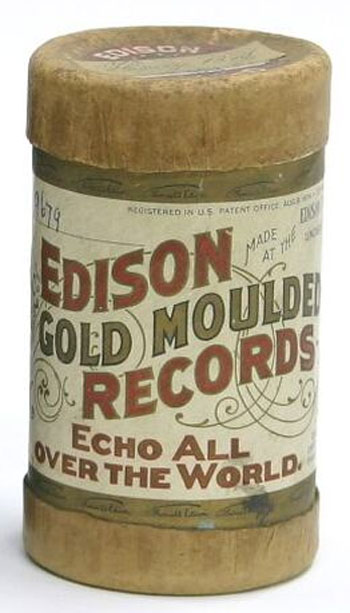
"Echo all over the World"
1899; Edison Records Catalog (1901) and Gold Moulded Record;
"Echo
All Over the World" - Edison ad, 1900

"Echo All Over
the World," Edison ad, 1901
revolutionary
adjective - involving or causing
a complete or dramatic change. In the context of the phonograph
industry there have been many examples over the decades where
phonographs have been advertised would label 'revolutionary.'
For recent examples see Steelman's
1957 "Revolution in Hi-Fidelity" Phonograph, Philips'
1978 Revolutionary
Series 7 turntables and Crosley's
2010 "Revolution" model, a USB Portable turntable.
In fact all phonograph turntables literally revolve to play records
and could be called revolutionary.

single
noun. Single, in the music industry,
is a type of release, typically a song recording of fewer tracks
than an LP record or an album. This can be released for sale to
the public in a variety of different formats. In most cases, a
single is a song that is released separately from an album, although
it usually also appears on an album. Typically, these are the
songs from albums that are released separately for promotional
uses such as digital download or commercial radio airplay and
are expected to be the most popular. In other cases a recording
released as a single may not appear on an album. Wikipedia
The most common form of the vinyl
single is the 45 or 7-inch. The names are derived from its play
speed, 45 rpm, and the standard diameter, 7 inches (18 cm).
A 45 rpm single typically lasts
between 2 and 5 minutes. See Records'
Factolas for the longest playing 45 rpm single side ever recorded.
soundbox
A common designation for the reproducer
of an acoustic phonograph; it is usually applied to disc machines.
Its parts are the diaphragm, needle arm and screw, spring, cusions,
casing, and gasket. It was supplanted in the electric era by the
cartridge, or pickup. (Definition from The Routledge Guide
to Music Technology, Edited by Thom Holmes, Published by Routledge,
©2006 by Taylor & Francis Group)
"sounds like a broken record"
When someone repeats themselves,
usually in a tiresome or annoying manner, the reference to sounding
like a broken record can be used. This description refers to a
time when records, when worn or scratched, were prone to the needle
getting stuck in the same groove, and thus repeated the same track
over and over.
James Thurber's story in "My Life
and Hard Times" about a record he grew up with called "No News,
or What Killed the Dog?" is a classic example of this reiterative
phenomenon.
"Father was
usually in bed by nine-thirty and up again by ten-thirty to protest
bitterly against a Victrola record we three boys were in the habit
of playing over and over, namely, "No News, or What Killed the
Dog," a recitation by Nat Wills. The record had been played so
many times that its grooves were deeply cut and the needle often
kept revolving in the same groove, repeating over and over the
same words. Thus: "ate some burnt hoss flesh, ate some burnt hoss
flesh, ate some burnt hoss flesh." It was this reiteration that
generally got father out of bed."
stylus
n. The point (usually sapphire or
diamond) of the REPRODUCER which rides the grooves of the recording
and transmits vibrations to the DIAPHRAGM or PICK-UP. (Definition
from The Talking Machine by Fabrizio and Paul) TMC2.
talking book
1. A recorded book. See Matthew
Rubery, The Untold Story of the Talking Book, Harvard University
Press, ©2016, p. 2. As Rubery explains, "talking book"
is an "expansive term to cover all recorded books" although
it has often been used "interchangeably with "audiobook"
to describe any narrative recorded onto a record, cassette tape,
compact disc, MP3 digital file, or other audio format." Rubery's
historical review of "phonographic books" in the first
50 years after the phonograph's invention, to the talking books
of the 1930's, "spoken word records" in the 1950's,
the books on tape in the 1970's up to the Audio Publishers Association's
confirmation in 1994 of "audio book" as the standard,
concludes that the term "audiobook" is the "most
useful one we've got" even though "using the phrase
for spoken word recordings made before that date is anachronistic."
Ibid. p 2.
Talking Toy
1. A toy that talks using a phonograph
record.
2. A toy that uses a phonograph
record to provide sound effects.
See Hasbro's
Knuckle Busters - Toy includes 45 RPM record to provide ring-side
sounds, 1973
See phonograph
game for toys that are primarily board games or games
of chance/gambling that use phonograph records.
Talking Toy Hall of Fame
Toys selected by Friends of the
Phonograph as inductees of Phonographia's Talking Toy Hall
of Fame meet one or more of the following requirements:
Popular Culture: The toy
has been seen in multiple formats of popular culture, e.g.,
cartoons, movies, advertisements, stories, etc., which reflect
its place in popular culture. This toy popularized the attribute
of sound coming from a toy. Market success may also be another
indicator.
Design: Introduced or creatively
made sound a significant part of the toy's identity or intended
activity/purpose.
Historical Impact: The
first or best example of a toy that realized one of Edison's
original predictions for a talking toy.
Top-five List "
List making happens for many reasons
but in the world of recordings the 'top-five list" means
selecting five favorites songs. The list can be "pure"
favorites or it can be based on a theme, e.g., top-five
songs related to death or love, etc.
Top-five list making was a running
activity in the movie "High-Fidelity" starring John
Cusask who made a habit of creating tapes of his favorites for
friends. As a record store owner Cusak also engaged in competition
with his employees (e.g., Jack Black) to pick top-fives for various
topics (e.g., Laura's father passing).
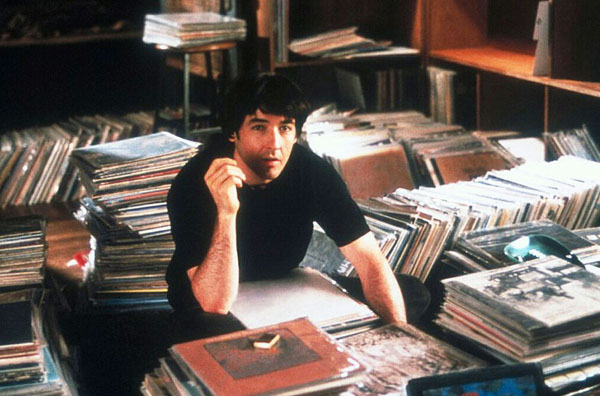
Top-five list maker
John Cusack in "Hi-Fidelity", courtesy Touchstone Pictures.
"Your Hit Parade"
"Your Hit Parade" was
a popular radio show in the 1930's that continued through the
1950's.
Before disc jockeys and Top-40 charts
became commonplace, there was Your Hit Parade, a radio institution
that billed itself as “an accurate, authentic tabulation of America's
taste in popular music.”
Every Saturday night, Your Hit Parade
presented the top tunes of the week, saving the top three songs
for the end of the show. As a nod to longtime sponsor Lucky Strike
Cigarettes, Your Hit Parade occasionally featured an old favorite
as a “Lucky Strike Extra.”
Batten, Barton, Durstine & Osborne,
the show’s advertising agency, remained secretive about the methods
used to determine the top songs. It was acknowledged that Your
Hit Parade’s statisticians examined sheet music sales and jukebox
tabulations before reaching their conclusions.
Your Hit Parade debuted on April
20, 1935 and moved between NBC and CBS until January 16, 1953.
A television version of Your Hit Parade was simulcast over NBC
Radio from 1950 to 1959.
(Text and information courtesy of
the Radio Hall of Fame.org)
"vaccinated with a phonograph
needle"
Phrase used in Marx Brothers 1933
movie "Duck Soup" addressed to someone who just kept
talking and talking: "You know, you haven't stopped talking
since I came here. You must have been vaccinated with a phonograph
needle."
Valentinogram
noun. A card given by a Phonographian
on Valentine's Day, February 14, with graphics or words that have
a connection with the phonograph.
Etymology. From Saint Valentine,
the 3rd-century patron saint who since the Middle Ages has been
associated with the tradition of 'courtly' and romantic love +
grámma the Ancient
Greek meaning "letter" or "something written"
(e.g., Emile Berliner's Gramophone and "a distant
message" telegram).
Example. "As a matter of
Record, I want you for my Valentine." "Re-cord me as
your Valentine!"
vaudeville - "a type
of entertainment popular chiefly in the US in the early 20th century,
featuring a mixture of specialty acts such as burlesque comedy
and song and dance." - Oxford Languages Dictionary
Many songs heard in vaudeville originated
in sheet music from broadway shows, traveling shows and musical
theaters. Some vaudeville music has been preserved on records.
Recorded sound would also be important for the evolution of talking
pictures and famously for one of the first, Al Jolson in The
Jazz Singer. Although Jolson's movie was neither the first
sound on film movie nor was the whole movie recorded for sound
it remains important in the history of movies. Unfortunately its
racism and stereotypical use of blackface require a disclaimer
and diminish its legacy.
Victrola
The Victor Talking Machine Company
named their new cabinet internal horn Victor model the Victor-Victrola
in August 1906. The Victrola was a trademarked name but
it also became a generic term for any talking machine, similiar
to how 'Kodak' became a generic name for any camera.
Many other manufacturers followed
Victor with internal horn machines and many added '-ola' to their
company name. For the etymology of Victrola and for a list of
'-ola' talking machines go to Phonographia Factola "The
'-Ola' Brands".
vinyl
noun. Phonograph record, commonly
referred to as "vinyl" because they were made with PVC (Polyvinyl
chloride, a particular vinyl polymer). Although there was a resurgence
of popularity of vinyl records in the 2010's there nevertheless
continues to be a debate about the sound quality of vinyl records
vs. digital records. Perhaps the best defense of vinyl, however,
came from singer-songwriter Neil Young who observed in a CNN 2012
interview, that "Steve Jobs was a pioneer of digital music, but
when he went home, he listened to vinyl."
Wizard of Menlo Park
Newspapers gave Thomas Alva Edison
this accolade after his invention of the Phonograph because of
the public's astonishment that a device could "bottle up"
and play back sound for future generations. Calling it astounding,
miraculous, the wonder of an age, witchery, etc., it seemed appropriate
to call Edison a Wizard. The Phonograph was invented at Edison's
Menlo Park, New Jersey Laboratory Complex, one of the earliest
examples of a research and development facility.
When Edison moved his laboratory
to West Orange, New Jersey the Menlo Park facility was basically
abandoned and by the time Henry Ford wanted to honor Edison and
include the Menlo Park buildings into his Greenfield Village only
a few bricks and planks and some New Jersey dirt could be salvaged.
To see the Menlo Park buildings that Ford had reconstructed in
Greenfield Village (Dearborn, Michigan), visit PhonoAvenue
(Phonographia's Virtual Street of Phonograph Museums) and
its link to Edison's Menlo
Park Laboratory.

Lithograph from Puck,
May 5, 1880
J. Keppler cartoon
"The Decadence Of The Wizard Of Menlo Park - From The Phonograph
To Polyform."

Illustration from
cover of July 9, 1879 New York Daily Graphic (with drawing
of his phonograph on his robe)

Edison the Alchemist
- "Like turning Iron to Gold" The Booklovers Magazine,
1905
wooden nickel (a.k.a. wooden money)
An American adage, "Don't take any
wooden nickels", is considered a lighthearted reminder to be cautious
in one's dealings. (Wikipedia).
The phrase is believed to have begun in the United States at the
beginning of the twentieth century.
The cautionary aspect is related
to being taken
advantage of by unscrulpulous people, particularly by those in
the big city. It also seems connected to the popular culture belief
that those living in the country might be naive in the ways of
the big city and that there are differences between city and country
lifestyles and morals. That belief, however, didn't begin in the
19th century as countless generations heard examples told in stories
going back to at least the
6th century BCE with Aesop's Fable "The Town
Mouse and the Country Mouse."
See "Historically
Speaking" which cites pre-Depression era use of "Don't
take any wooden nickels" with an article in the Chicago
Daily Tribune on February 11, 1925 which reported: He was
the kind of man who calls back, “Don't take any wooden nickels”
as he disappears through the door.)
"Wooden money"
is a product made out of wood. It's description as a type of "money"
makes it seem like it has value, like "paper money."
But it's more similar to "play money." Because it's
made out of wood (and not a "green back" issued by the
United States government) it's considered counterfeit
if there is any attempt to pass it as government issued currency.
It has no value except as a consumer item with its value as a
souvenir, collectible, trade token, etc. Therefore, popular culture
advice about not taking any "wooden nickels" would have
been the same for not taking any "wooden money."
As an example, the following is
the warning published in Edison's convention's program for his
July 1920 phonograph dealer's convention held in New York City
as reported by The Talking
Machine World:
The dealers and others attending
the Edison Convention without exception followed the advice offered
in the program which read: "Don't take any wooden money--or
alcohol. Despite what is said by one of the characters in the
skit, 'After the Nut Is Off,' there is no perfectly safe booze
for sale in New York." The
Talking Machine World, July15, 1920
(Note: The 18th Amendment was ratified
on January 16, 1919 and the country went dry at midnight on January
17, 1920. Hooch, rotgut and bathtub gin were supplementing
the smuggled and bootlegged alcohol and those substitutes during
Prohibition could be fatal).
"Don't Take Any Wooden Nickels!"
as common sense
During World War II the following
poster was issued by the United States government using the phrase
"Don't take any wooden nickels!" in the context of listening
to bad advice and tall tales. "Remember, four cents are worth
more than a wooden nickel anytime!

Office for Emergency
Management, War Production Board (circa 1942–43)
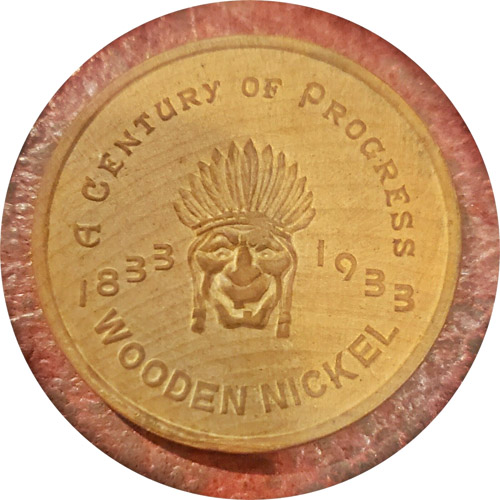
"The Chicago World's
Fair in 1933 issued wooden nickels as souvenirs, and the tradition
of wooden nickels as tokens and souvenirs continues to the present
day." Wikipedia
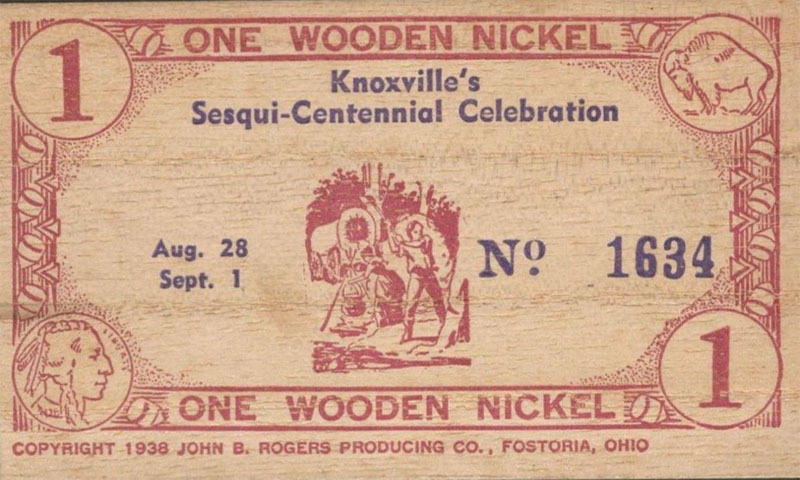
1938 Wooden Nickel
issued for Knoxville's Sesqui-Centennial Celebration

Wooden Nickel token
1979 (FP-0998B)
"NIPPER"
RETURNS TO RCA CAMDEN, N.J, APRIL 1979

|
